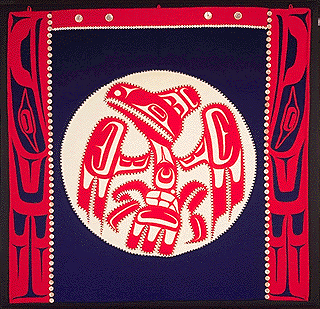DCHP-2
button blanket DCHP-2 (October 2016)
n. — Aboriginal, especially First Nations
a cape ornamented with family crests, using white buttons in the design, worn as regalia at feasts and other important events by First Nations peoples of the West Coast.
Type: 4. Culturally Significant — Button blankets are worn at potlatches and feasts by members of West Coast First Nations. At traditional naming ceremonies, a button blanket with the individual's family crest is presented to the recipient (see the Canadian Museum of History reference).
See also COD-2, s.v. "button blanket", which mentions "Aboriginal peoples of the Pacific Coast of North America", Gage-5, s.v. "button blanket", which is marked "Cdn.", ITP Nelson, s.v. "button blanket", which mentions "Aboriginal peoples of the Pacific Coast".See also: potlatch ((n.)) thunderbird cape
References:
- COD-2
- Canadian Museum of History "Treasures Gallery: Button Blankets" Accessed 4 Feb. 2013
- Gage-5
- ITP Nelson
Images:

Image 1: A Haida button blanket made in 1987. Source: Canadian Museum of Civilization. Artist: Dorothy Grant